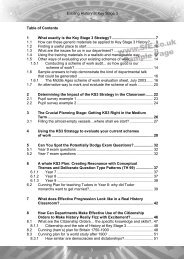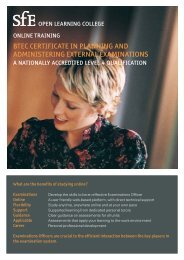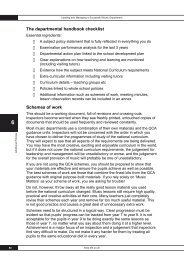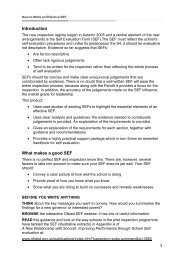Experiential RE supdocs.indd - SfE
Experiential RE supdocs.indd - SfE
Experiential RE supdocs.indd - SfE
You also want an ePaper? Increase the reach of your titles
YUMPU automatically turns print PDFs into web optimized ePapers that Google loves.
Religion neutral exercises and participatory symbols<br />
Over the years in my <strong>RE</strong> lessons, these have become increasingly important as a way of making<br />
<strong>RE</strong> make sense and most importantly to enable pupils to enter into the experience of someone<br />
very different from themselves.<br />
Religion neutral exercises are activities that are planned to parallel the aspect of a tradition that<br />
you are teaching. They are religion neutral because they are not directed toward a divine being<br />
and are, if you like, tradition neutral. For example:<br />
A religion neutral exercise to help pupils understand the meaning of the Christian Eucharist<br />
Passing bread and water round a circle and reflecting on the symbolism of passing them to<br />
each other, together with tasting the bread and touching the water, enables pupils to reflect<br />
on the symbolism of sharing, being nourished, being cleansed and given life. When pupils are<br />
then asked to read the Eucharistic words of institution and think about what Christians believe<br />
is happening when they take bread and wine at Holy Communion, all the complicated theology<br />
suddenly makes sense. Together, with their community, they are being nourished, cleansed and<br />
given life. Answering a GCSE question on the value and effects of Christian worship suddenly<br />
becomes something that pupils can respond to meaningfully, as opposed to greeting it with blank<br />
incomprehension: ”How could anybody find that valuable?!”<br />
What also happens is that pupils are able to reflect on the transforming power of symbol and<br />
ritual. They begin to make sense, rather than remaining these rather bizarre activities, which other<br />
people do, and which have “nothing to do with us, or anything that we know”.<br />
A religion neutral exercise to help pupils understand the meaning of the Tefillin for Jews<br />
Show a group of Year 8s (age 12/13), for example, a picture of an Orthodox Jew in Tallit (prayer<br />
shawl) and Tefillin (small leather boxes containing special pieces of scripture and strapped to the<br />
forehead and arm) and they are liable to laugh.<br />
Explaining what is happening in the picture and/or reading from a book or worksheet is not likely<br />
to improve the situation. It is not just about information but also about prejudice, racism and<br />
being different.<br />
However, when asked to write on a strip of paper, something very important in their lives, a hope<br />
or wish or a special person and to fold it carefully and place it in a small box which is then placed<br />
for one minute against the forehead where they think about the person, the heart, where they feel<br />
loving thoughts for the person and finally held in their hands, where they think what they can do<br />
to help the person, there is a dramatic change. Pupils no longer find the idea of Jews wearing<br />
Tefillin amusing; they have usually been deeply moved by their own reflection during the religion<br />
neutral activity; their own spiritual awareness developed a little. Empathy is developed, racism is<br />
being eroded. Emotional intelligence is developing. Their ability to evaluate, answering a GCSE<br />
examination question, such as “It is silly to dress up for prayer. In your answer give more than<br />
point of view” is greatly enhanced.<br />
Participatory symbols<br />
This is a term used by Paul Tillich in his book Religious Language. In it he says that there are<br />
some symbolic actions (things we do), which we humans take which enable us to understand<br />
something at a much deeper level than if we simply described it. These actions, like eating<br />
symbolic food, giving gifts, wearing special clothes or giving a ring, help us feel changed. We can<br />
actually experience the spiritual change of a rite of passage, for example, through these actions.<br />
In class we can recreate this, enabling our pupils to experience spiritual growth spurts through<br />
developing awareness and promoting change. We can do this by inviting them to reflect and then<br />
10 <strong>Experiential</strong> <strong>RE</strong>: Supporting documents








